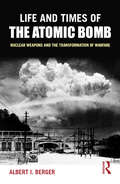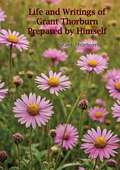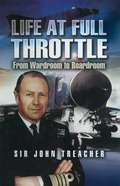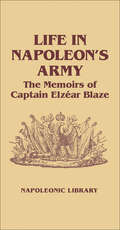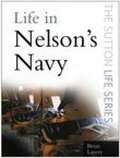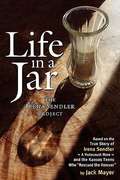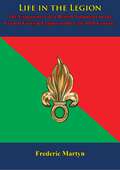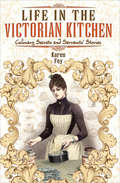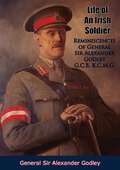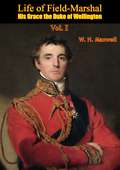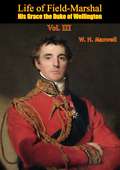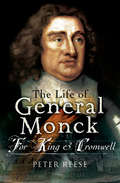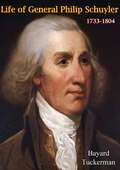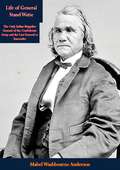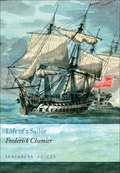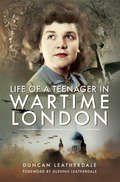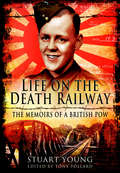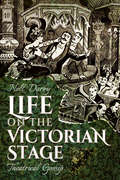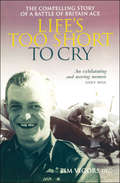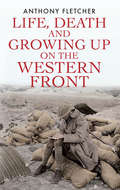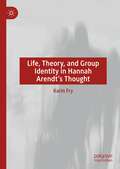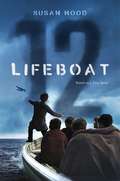- Table View
- List View
Life and Times of the Atomic Bomb: Nuclear Weapons and the Transformation of Warfare
by Albert I BergerLife and Times of the Atomic Bomb takes up the question of how the world found itself in the age of nuclear weapons – and how it has since tried to find a way out of it. Albert I. Berger charts the story of nuclear weapons from their origins through the Atomic Age and the Cold War up through the present day, arguing that an understanding of the history of nuclear weapons is crucial to modern efforts to manage them. This book examines topics including nuclear strategy debates, weapon system procurement decisions, and arms control conferences through the people and leaders who experienced them. Providing a chronological survey, Life and Times of the Atomic Bomb starts with the major scientific discoveries of the late 19th century that laid the groundwork for nuclear development. It then traces the history of nuclear weapons from their inception to the atomic bombings of Hiroshima and Nagasaki in 1945 and the reaction to them by key players on both sides. It continues its narrative into the second half of the twentieth century, and the role of nuclear weapons throughout the Cold War, engaging in the debate over whether nuclear weapons are an effective deterrent. Finally, the closing chapters consider the atomic bomb’s place in the modern world and the transformation of warfare in an age of advanced technology. This clear and engaging survey will be invaluable reading for students of the Cold War and twentieth-century history.
Life and Writings of Grant Thorburn Prepared by Himself
by Grant ThorburnBorn in Scotland in 1773, Thorburn learned from his father to make nails and became an expert. In 1794 he immigrated to New York, as he says in the Preface "with only three cents in my pocket, and my nail-hammer in my hand." Thorburn immediately found employment in that profession (the nature of the nail-making business is described here in detail). Soon however the invention of the nail-cutting machine deprived him of an occupation. He went to work as a grocer and became interested in plants. When purchasing his first plant, he claims that he "knew not a geranium from a cabbage." But by 1803, according to the DAB, he "became the first seedsman of any consequence in America and came to found a business that functioned for more than a century." In 1812, Thorburn issued the first seed catalogue in American history. Among the events from his life described here are providential escapes, a scene at sea, and accounts of the New York yellow fever epidemic in 1822. Thorburn also took to writing, having assumed "Lawrie Todd" as a pen name. His collective successes allowed him to indulge his propensity for mingling with the rich and famous. According to the DAB, Thorburn "jeopardized his standing with his church by cultivating an acquaintance with Thomas Paine" author of COMMON SENSE. Thorburn includes here a number of Paine anecdotes, including one about Paine's narrow escape from execution in France, and the remarks Paine made on his death-bed. There is a 17-page appendix of correspondence between Paine and William Carver. Another appendix is entitled "Hints to Gardeners Wishing to Emigrate to the United States." Thorburn "was very proud of being the original of the hero of John Galt's LAWRIE TODD, the first novel with Rochester, New York, for its setting."—Sabin 95610. Howes T-219.
Life at Full Throttle: From Wardroom to Boardroom
by John TreacherBy any standards, Admiral Sir John Treacher is an exceptional man who has had the fullest of lives. Old enough to have served and be sunk in the War, he went to be a naval aviator flying in the Korean War. His career took ff too and he rose rapidly to be the captain of the aircraft carrier HMS Eagle and soon after Commander in Chief Channel. To everyone's surprised he left the Navy when all the indications were that he was about to become First Sea Lord. For many this would have meant a quiet retirement. Not so here! A number of influential appointments quickly followed including controversially Chairmanship of Playboy Club UK at a critical time for their vital gaming interests. He was deeply embroiled in the highly political Westland drama which resulted in the resignation of Cabinet ministers. Today as he approaches 80 he is still an active and influential figure in the aeronautical industry.
Life in Napoleon's Army: The Memoirs of Captain Elzéar Blaze (Napoleonic Library #Vol. 28)
by Philip HaythornthwaiteThe Napoleonic Library is an outstanding collection of seminal works on the Napoleonic Wars. It features evocative contemporary memoirs and makes available once again the classic works on the subject by military historians.
Life in Nelson's Navy
by Brian LaveryWhat was it really like to be at sea in the Navy with Nelson? Were the sailors excited about the Battle of Trafalgar, or suffering scurvy? How did life compare between those of a high range, and those who served them? What were conditions like below the decks, living among the rats and the filth? How did you cope if you suffered from sea sickness? This book takes you back in time to see, hear, smell and taste what life was really like for these brave sailors at sea.
Life in a Jar: The Irena Sendler Project
by Jack MayerDuring World War II, Irena Sendler, a Polish Catholic social worker, organized a rescue network of fellow social workers to save 2,500 Jewish children from certain death in the Warsaw ghetto. Incredibly, after the war her heroism, like that of many others, was suppressed by communist Poland and remained virtually unknown for 60 years. Unknown, that is, until three high school girls from an economically depressed, rural school district in southeast Kansas stumbled upon a tantalizing reference to Sendler's rescues, which they fashioned into a history project, a play they called Life in a Jar. Their innocent drama was first seen in Kansas, then the Midwest, then New York, Los Angeles, Montreal, and finally Poland, where they elevated Irena Sendler to a national hero, championing her legacy of tolerance and respect for all people. Life in a Jar: The Irena Sendler Project is a Holocaust history and more. It is the inspirational story of Protestant students from Kansas, each carrying her own painful burden, each called in her own complex way to the history of a Catholic woman who knocked on Jewish doors in the Warsaw ghetto and, in Sendler's own words, "tried to talk the mothers out of their children." Inspired by Irena Sendler, they are living examples of the power of one person to change the world and models for young people everywhere. ***** 60% of the sales of this book are donated to the Irena Sendler/Life in a Jar Foundation. The foundation promotes Irena Sendler's legacy and encourages educators and students to emulate the project by focusing on unsung heroes in history to teach respect and understanding among all people, regardless of race, religion, or creed.
Life in the Legion: The Experiences of a British Volunteer in the French Foreign Legion in the Late 19th Century
by Frederic MartynOn campaign under the tricolor“This is an essential book for all those interested in the French Foreign Legion because it is a brilliant first hand account written by an English 'gentleman volunteer' who experienced 'life in the legion' in the late 1880's and who had previously been a serving officer in one of the cavalry regiments of the British Army. Far from being a tale of hardship and abuse, the author had nothing but admiration for the Legion and—as an experienced soldier—obviously thoroughly enjoyed the five years he spent serving in its ranks. The writer quite simply could not have enough action and he volunteered to serve in Tonkin, Dahomey and against the Tuareg tribesmen of North Africa. In consequence this book is full of colourful and detailed campaign and battle action which is compellingly recounted by a fighting soldier more than capable of putting his engrossing story into words. Highly recommended.”-Print ed.
Life in the Victorian Kitchen: Culinary Secrets and Servants' Stories
by Karen FoyA fascinating and deeply researched behind-the-scenes journey into Victorian-era kitchens, with authentic nineteenth-century techniques, tips, and recipes. Have you ever wondered what life was like for domestic servants, the etiquette involved during upper class banquets, or simply wished for a glimpse of day-to-day life in the Victorian kitchen? During the nineteenth century, the kitchen was a place where culinary worlds collided, bridging the gap between social classes. From the rural cottage to the well-staffed country house, Karen Foy takes readers on an entertaining and informative journey through a lost culinary world, uncovering the customs, traditions, and history surrounding some of Britain&’s best loved dishes. Discover nineteenth-century tips, techniques, stories, and superstitions. Try your hand at using an egg to foretell the future, or timeless recipes for everything from apple wine to sheep&’s head pie.
Life of An Irish Soldier: Reminiscences of General Sir Alexander Godley G.C.B. K.C.M.G.
by General Sir Alexander GodleyThe memoirs of General Sir Alexander Godley, whose military career spanned five decades at the end of the 19th Century and in to the firestorm of the First World War at Gallipoli and the Western Front.“General Sir Alexander John Godley, GCB, KCMG (4 February 1867–6 March 1957) was a senior British Army officer. He is best known for his role as commander of the New Zealand Expeditionary Force and II Anzac Corps during the First World War.Born in Gillingham, Kent, in England, Godley joined the British Army in 1886. He fought in the Boer War and afterwards served in a number of staff positions in England. In 1910 he went to New Zealand as Commandant of the New Zealand Military Forces. Promoted to temporary major general, he reorganised the country's military establishment. Following the outbreak of the First World War, the New Zealand government appointed him as commander of the New Zealand Expeditionary Force, which he led for the duration of the war.”-Wiki
Life of Charles Carroll of Carrollton
by Lewis Alexander LeonardCharles Carroll played a big part in the drama of American Independence, a far bigger part than is popularly supposed. School histories dismiss him with a few lines and most histories give larger space to men who played for minor parts. For this reason historical justice has never been fully accorded to Charles Carroll. This book corrects that injustice. Its author, a Marylander by birth, with the zeal and enthusiasm of a native son for his own heath, its traditions and its men of note, has given years to the research needed to unearth such a mine of historical knowledge. And with him it has been a labor of love. His forbears were intimately connected with the Carrolls and so Mr. Leonard has more than musty old records for the source of his inspiration. I believe that he has done simple justice to the name and fame of Charles Carroll and nothing more. The great pity is, it was not done years ago.George Washington had no truer, no stauncher friend than Charles Carroll, though the world has partially blinked the fact. Others of the Colonial fathers might waver here, and falter there, but Charles Carroll always upheld the hands of Washington as Aaron and Hur upheld the hands of Moses in his battle with Amalek. In this country Charles Carroll saw the Promised Land for which sages had sighed and philosophers had dreamed and for it he risked his all on the turn of the Revolutionary die, and his all was more in worldly goods than any other signer of the Declaration of Independence.
Life of Field-Marshal His Grace the Duke of Wellington Vol. I (Life of Field-Marshal His Grace the Duke of Wellington #1)
by W. H. MaxwellOriginally published in 1839, this is the FIRST volume in a series of three published between 1839-1841, which together form an impressive biography of Field-Marshall Arthur Wellington, 1st Duke of Wellington (1769-1852), one of the leading military and political figures of 19th-century Britain whose defeat of Napoleon at the Battle of Waterloo in 1815 put him in the top rank of Britain’s military heroes. Written when witnesses of the Iron Duke’s exploits were still alive, Maxwell used much firsthand information was available from serving a discharged military personnel to enrich the narrative.In this volume the future Duke’s career is taken up to his arrival to take command in the Peninsula for the second time after Moore’s disastrous retreat in 1809.Richly illustrated throughout with steel and wood engravings.
Life of Field-Marshal His Grace the Duke of Wellington Vol. II (Life of Field-Marshal His Grace the Duke of Wellington #2)
by W. H. MaxwellOriginally published in 1840, this is the SECOND volume in a series of three published between 1839-1841, which together form an impressive biography of Field-Marshall Arthur Wellington, 1st Duke of Wellington (1769-1852), one of the leading military and political figures of 19th-century Britain whose defeat of Napoleon at the Battle of Waterloo in 1815 put him in the top rank of Britain’s military heroes. Written when witnesses of the Iron Duke’s exploits were still alive, Maxwell used much firsthand information was available from serving a discharged military personnel to enrich the narrative.In this volume the Duke’s career is recounted up to his huge success at the battle of Salamanca in 1812.Richly illustrated throughout with steel and wood engravings.
Life of Field-Marshal His Grace the Duke of Wellington Vol. III (Life of Field-Marshal His Grace the Duke of Wellington #3)
by W. H. MaxwellOriginally published in 1841, this is the THIRD volume in a series of three published between 1839-1841, which together form an impressive biography of Field-Marshall Arthur Wellington, 1st Duke of Wellington (1769-1852), one of the leading military and political figures of 19th-century Britain whose defeat of Napoleon at the Battle of Waterloo in 1815 put him in the top rank of Britain’s military heroes. Written when witnesses of the Iron Duke’s exploits were still alive, Maxwell used much firsthand information was available from serving a discharged military personnel to enrich the narrative.In this volume the Duke’s career is recounted culminating in his victory on the field of Waterloo.Richly illustrated throughout with steel and wood engravings.
Life of General George Monck: For King and Cromwell
by Peter ReeseGeneral George Monck is famous for the key role he played in the restoration of the monarchy in 1660. His actions changed the course of British history, but his statesmanship in the dangerous time between the death of Cromwell and the bloodless return of Charles II distracts attention from his extraordinary career as a soldier and general, admiral, governor and administrator. During the confused, often bloody era of the English Civil Wars and the Protectorate he was one of the great survivors. Peter Reese, in this perceptive new study, follows Monck through his long, varied career, from his impoverished upbringing in the West Country and his military apprenticeship on the Continent, to his experience as a commander on both sides during the civil wars. He distinguished himself on the battlefields of Ireland and Scotland, and as a general-at-sea for both Cromwell and Charles II. His shrewdness and firmness of character, his skill as a leader, his high popularity with his troops and his occasional ruthlessness gained for him a formidable reputation. On Cromwell's death he was one of the few men in England with the power, personal authority and political skill to secure the restoration of Charles II and to bring to an end twenty years of conflict.
Life of General Philip Schuyler, 1733-1804
by Bayard TuckermanPhilip John Schuyler served as a major general in the Continental Army during the American Revolution and was a member of the First United States Senate. Schuyler played a key role in the American victory at the Battle of Saratoga, as well as in earlier campaigns including the Invasion of Canada, and the Battles of Lake Champlain and Fort Ticonderoga. Coming from a family deeply rooted in the Dutch-influenced culture of New York, Schuyler was a member of the civic and social elite representing New York in the Continental Congress and the United States Senate.-Mount Vernon.org
Life of General Stand Watie: The Only Indian Brigadier General of the Confederate Army and the Last General to Surrender
by Mabel Washbourne AndersonWatie was born in 1806 near Calhoun Georgia. Watie left for the Indian Territory in 1835 and was one of the Cherokee leaders before the Civil War. He was the only Native American Confederate General commanding the Confederate Indian Cavalry of the Army of the Trans-Mississippi. Watie was the highest ranked Native American in the Confederate army and renowned for his leadership in the Battle of Pea Ridge and other battles. He also was the last Confederate general to surrender, three months after Lee at Appomattox. Watie was the last Confederate General to surrender in June 1865. The author was the grandniece of Stand Watie.
Life of Prince Metternich
by Col. G. B. MallesonOriginally published in 1888, this is a short biography of the life of Prince Klemens Wenzel von Metternich (15 May 1773 - 11 June 1859), a politician and statesman of Rhenish extraction and one of the most important diplomats of his era, serving as the Austrian Empire's first Foreign Minister from 1809 and then Chancellor from 1821. He was a great diplomat: crafty, manipulative, and single-minded in his determination to overthrow Napoleon and his revolutionary ideals and to re-establish the European monarchical system.Here, British Colonel G. B. Malleson describes how the charming, aristocratic Metternich devoted countless hours to winning Napoleon's trust and to buying time for his country, until a re-armed Austria, at the head of the Sixth Coalition, was able to defeat the still-formidable Corsican. From 1815 until his downfall amid the revolutions of 1848, notes Malleson, Metternich devoted "all his power, all his influence, all his untiring energy, to the forging of new fetters for the human race."This compact but succinct title makes an important addition to your history collection.
Life of a Sailor: By Capt. Frederick Chamier, R. N. (Seafarers' Voices)
by Frederick ChamierChamier was a Royal Navy officer, who like his exact contemporary Captain Marryat is best remembered for a series of naval novels. The Life of a Sailor was his first publication and is usually catalogued as fiction, which may be a tribute to Chamiers story-telling skills but it is wrong the book is an exact account of his naval career, with every personality, ship and event he describes corroborated by his service records. By the time he went to sea in 1809, the heroic age of Nelson was over, but the war was far from won, and he was to see a lot of action, from anti-slavery patrols off Africa to punitive raids on the American coast during the War of 1812.His descriptions of the latter were to prove highly controversial. Like many liberal officers, he deplored the strategy of bringing the war to the civilian population, and the book was much criticised by more senior naval officers for saying so. Chamier represents a new generation of post-Nelsonic naval officer, more gentlemanly, better educated and perhaps more open-minded he certainly got on well with Lord Byron, whom he met in Constantinople and his sympathies generally look forward to the Victorian age. He was too young to rise to high rank, and after the Napoleonic War, like many others, he was condemned to a life on half-pay and perhaps forced into a literary career, but out of it came one of the eras most authentic accounts of a junior officers naval service.
Life of a Teenager in Wartime London
by Duncan LeatherdaleLife in wartime London evokes images of the Blitz, of air-raid shelters and rationing, of billeted soldiers and evacuated children. These are familiar, collective memories of what life was like in wartime London, yet there remains an often neglected area of our social history: what was life like for teenagers and young people living in London during the Second World War?While children were evacuated and many of their friends and family went to fight, there were many who stayed at home despite the daily threat of air raids and invasion. How did those left behind live, work and play in the nation's capital between 1939 and 1945? Using the diary entries of nineteen-year-old trainee physiotherapist Glennis 'Bunty' Leatherdale, along with other contemporary accounts, Life of a Teenager in Wartime London is a window into the life of a young person finding their way in the world. It shows how young people can cope no matter the dangers they face, be it from bombs or boys, dances or death.
Life on the Death Railway: The Memoirs of a British POW
by Stuart YoungAs a young man Stuart Young endured the horrors of the Japanese prisoner-of-war camps and survived. Later in life, in graphic detail, he recorded the experience the dreadful conditions, the brutal treatment, the sickness and starvation, the merciless routine of forced labour. Yet he also recorded the comradeship among the prisoners, their compassion and strength, and the pastimes and entertainments that helped them to come through an ordeal that is hard to imagine today. First he was held at the notorious Changi camp in Singapore Island, then in the camps in Thailand that accommodated POWs who were forced to work on the Death Railway. Perhaps the most revealing passages of his memoir recall the daily experience of captivity - the ceaseless battle to survive the backbreaking work, the cruelties of the guards and ever-present threat of disease. His account gives a harrowing insight into the daily reality of captivity and it shows why he was determined to document and make sense of what he and his fellow prisoners suffered.
Life on the Victorian Stage: Theatrical Gossip
by Nell DarbyThe expansion of the press in Victorian Britain meant more pages to be filled, and more stories to be found. Life on the Victorian Stage: Theatrical Gossip looks at how the everyday lives of Victorian performers and managers were used for such a purpose, with the British newspapers covering the good, the bad and the ugly side of life on the stage during the nineteenth century. Viewed through the prism of Victorian newspapers, and in particular through their gossip columns, this book looks at the perils facing actors from financial disasters or insecurity to stalking, from libel cases to criminal trials and offers an alternative view of the Victorian theatrical profession.This thoroughly researched and entertaining study looks at how the Victorian press covered the theatrical profession and, in particular, how it covered the misfortunes actors faced. It shows how the development of gossip columns and papers specializing in theater coverage enabled fans to gain an insight into their favorite performers lives that broke down the public-private divide of the stage and helped to create a very modern celebrity culture.The book looks at how technological developments enabled the press to expose the behavior of actors overseas, such as when actor Fred Solomon's' bigamy in America was revealed. It looks at the pressures facing actors, which could lead to suicide, and the impact of the 1857 Matrimonial Causes Act on what the newspapers covered, with theatrical divorce cases coming to form a significant part of their coverage in the latter half of the nineteenth century. Other major events, from theater disasters to the murder of actor William Terriss, are explored within the context of press reportage and its impact. The lives of those in the theatrical profession are put into their wider social context to explore how they lived, and how they were perceived by press and public in Victorian Britain.
Life's Too Short to Cry: The Compelling Story of a Battle of Britain Ace
by Tim VigorsA newly discovered “exhilarating and moving memoir” of an RAF fighter pilot in World War II (Daily Mail). It is not often that a long-hidden gem of a manuscript is published, bringing a moment in WWII history to vivid life for today’s readers. Geoffrey Wellum’s First Light was one example. The memoir of Timothy Vigors is another. Born in Hatfield but raised in Ireland and educated at Eton and Cranwell, Vigors found himself in France in 1940 flying Fairey Battle bombers. After the Fall he joined the fighters of 222 Squadron, with whom he saw frantic and distinguished service over Dunkirk and persevered through the dangerous days of the Battle of Britain, when he became an ace. Vigors transferred to the Far East in January 1941 as a flight commander with 243, then to 453 Squadron RAAF, and on December 10 of that year he led a flight of Buffaloes to cover the sinking Prince of Wales and Repulse. Dramatically shot down, burnt and attacked on his parachute, he was evacuated to Java, and from there, to India. As he describes these experiences in his handwritten account, the author provides a fascinating and valuable record, a newly discovered personal narrative of air combat destined to be seen as a classic.
Life, Death and Growing up on the Western Front
by Anthony FletcherThis book was inspired by the authors discovery of an extraordinary cache of letters from a soldier who was killed on the Western Front during the First World War. The soldier was his grandfather, and the letters had been tucked away, unread and unmentioned for many decades. Intrigued by the heartbreak and history of these family letters, Fletcher sought out the correspondence of other British soldiers who had volunteered for the fight against Germany. This resulting volume offers a vivid account of the physical and emotional experiences of seventeen British soldiers whose letters survive. Drawn from different regiments, social backgrounds, and areas of England and Scotland, they include twelve officers and five ordinary "Tommies. " The book explores the training, journey to France, fear, shellshock, and life in the trenches as well as the leisure, love, and home leave the soldiers dreamed of. Fletcher discusses the psychological responses of 17- and 18-year-old men facing appalling realities and considers the particular pressures on those who survived their fallen comrades. While acknowledging the horror and futility the soldiers of the Great War experienced, the author shows another side to the story, focusing new attention on the loyal comradeship, robust humor, and strong morale that uplifted the men at the Front and created a powerful bond among them.
Life, Theory, and Group Identity in Hannah Arendt's Thought
by Karin FryPhilosophy typically ignores biographical, historical, and cultural aspects of theoriss’ lives in an attempt to take a supposedly abstract and objective view of their work. This book makes some new conclusions about Arendt’s theory by emphasizing how her experience of the world as displayed in her archival materials impacted her thought. Some aspects of Arendt’s life have been examined in detail before, including the fact she was stateless as well as her affair with Heidegger. Instead, this work explores different topics including the biographical and narrative moments of Arendt's own work, the role of archiving in her thought, pivotal events that have not been archived, her understanding of her own identities, and how it affected the role of identity politics in her work. Typically, group action is underemphasized in Arendt scholarship in comparison to individual action and often identity politics questions are considered to lie within the realm of the private. Although Arendt’s theory is problematic when discussing issues concerning identity politics, she did think identity politics could be public and political and that effective political actions may occur within groups. What makes this project unique are the innovative conclusions made by moving the archival and biographical evidence to the center in order to understand her theory more accurately and within its historical and cultural context. This volume will be of interest to professional scholars in Arendt’s work, but also to those who have a more general interest in her life and theory.
Lifeboat 12
by Susan HoodIn the tradition of The War That Saved My Life and Stella By Starlight, this poignant novel in verse based on true events tells the story of a boy’s harrowing experience on a lifeboat after surviving a torpedo attack during World War II. <P><P>With Nazis bombing London every night, it’s time for thirteen-year-old Ken to escape. He suspects his stepmother is glad to see him go, but his dad says he’s one of the lucky ones—one of ninety boys and girls to ship out aboard the SS City of Benares to safety in Canada. <P><P>Life aboard the luxury ship is grand—nine-course meals, new friends, and a life far from the bombs, rations, and his stepmum’s glare. <P><P>And after five days at sea, the ship’s officers announce that they’re out of danger. They’re wrong. Late that night, an explosion hurls Ken from his bunk. They’ve been hit. Torpedoed! <P><P>The Benares is sinking fast. Terrified, Ken scrambles aboard Lifeboat 12 with five other boys. Will they get away? Will they survive? <P><P> Award-winning author Susan Hood brings this little-known World War II story to life in a riveting novel of courage, hope, and compassion. Based on true events and real people, Lifeboat 12 is about believing in one another, knowing that only by banding together will we have any chance to survive.
